Simulation Study of Natural Gas Charging and Gas–Water Occurrence Mechanisms in Ultra-High-Pressure and Low-Permeability Reservoirs
Abstract
1. Introduction
2. Geologic Background
3. Samples and Methods
3.1. Samples
3.2. Methods
3.2.1. Observation of the Cast Thin Film
3.2.2. Core Displacement Experiment
- The core sample was dried and weighed, the diameter and length of the core were measured, and the core was placed into the gripper;
- The rock samples were vacuumed, saturated with brine under 20 MPa pressure for 24 h, weighed, and subjected to NMR T2 spectrum measurements;
- For NMR T2 spectrum measurements, gas (N2) from one end of the core column sample (inlet end) was used to replace the free water in the core until the gas flow rate at the outlet end was stabilized;
- The filling pressure of gas (N2) at the inlet end was increased, and step 2 was repeated until there was no change in the neighboring NMR T2 spectra twice;
- After gas-driving the core column samples based on different charging pressures, NMR T2 spectra were measured for the samples to analyze the changes in gas saturation and free water replacement in the sandstone samples.
3.2.3. Numerical Simulation of Two-Phase Flow
4. Results
4.1. Cast Thin Sheet Results
4.2. Core Displacement Results
4.3. Numerical Simulation Results
5. Discussion
5.1. Mechanism of Gas–Water Occurrence
5.2. Main Controlling Factors of Gas Water Distribution
5.2.1. Formation Temperature
5.2.2. Charging Pressure
5.2.3. Pore and Throat Distribution
5.2.4. Interfacial Tension
5.2.5. Wettability
6. Conclusions
- The pore throat structure of the low-permeability sandstone reservoirs of the Huangliu Formation in the Yinggehai Basin is complex, with significant high-porosity and low-permeability characteristics. Weak compaction and the dissolution of bottom-penetrating fluids make the reservoirs more porous, while a fine grain size, a small throat, more mud, and cementation lead to low reservoir permeability. The non-homogeneity of the pore throat structure and the difference in rock-forming action together shape the reservoir characteristics of “high porosity and low permeability”, which determines the local enrichment characteristics of the reservoir’s “sweet spot”.
- Natural gas is preferentially charged along the large borehole throat to form a continuous seepage channel, and stagnant water exists in the small throat and in the large borehole throat where the gas does not pass locally. Only when the filling pressure is greater than the capillary force in the small hole can it enter the small hole. When the filling pressure reaches 5 MPa, the radius of the pore throat that can be filled with natural gas ranges from 0.5 to 10 μm, and the radius of the pore throat that can be filled with natural gas when the filling pressure exceeds 16 MPa ranges from 0.01 to 0.5 μm. The gradient variation of the charging pressure reveals the hierarchical control of multi-scale pore throats on gas migration.
- The results of core driving and numerical simulation show that the reservoir’s pore throat distribution, formation temperature, and filling pressure are the main controlling factors for gas and water distribution in the low-permeability reservoir in the study area. The gas–liquid interface tension is the second factor, and the reservoir wettability has less influence on the gas saturation. The high-temperature and high-pressure environment can reduce the capillary force in the low-permeability reservoir and promote the formation of natural gas accumulation in the low-permeability reservoir. The synergistic effects of formation temperature and charging pressure dominate the gas–water distribution in low-permeability reservoirs. High-temperature and high-pressure conditions reduce capillary forces within these reservoirs, thereby enhancing their potential for natural gas accumulation.
- The results of this research provide new inspiration for the development of high-pressure, low-permeability gas reservoirs. Sweet spot prediction should prioritize reservoir sections with a high proportion of large orifices and good orifice sorting. The design of gas-charging programs should be combined with reservoir temperature and pressure conditions, and a high-temperature environment can reduce the start-up pressure gradient and improve gas-driving efficiency. For the development of areas with small throats, it is necessary to break through the capillary resistance using ultra-high-pressure gas charging or fracturing modification. In the future, we can combine this with 3D digital core technology to establish a pore and throat network model to further optimize development strategies.
Author Contributions
Funding
Data Availability Statement
Conflicts of Interest
References
- Holditch, S. Tight gas sands. J. Pet. Technol. 2006, 58, 86–93. [Google Scholar]
- Jia, C.; Zheng, M.; Zhang, Y. Unconventional hydrocarbon resources in China and the prospect of exploration and development. Pet. Explor. Dev. 2012, 39, 129–136. [Google Scholar]
- Zou, C.; Zhang, G.; Yang, Z.; Tao, S.; Hou, L.; Zhu, R.; Yuan, X.; Ran, Q.; Li, D.; Wang, Z. Geological concepts, characteristics, resource potential and key techniques of unconventional hydrocarbon: On unconventional petroleum geology. Pet. Explor. Dev. 2013, 40, 385–399+454. [Google Scholar]
- Li, G.; Lei, Z.; Dong, W.; Wang, H.; Zheng, X.; Tan, J. Progress, challenges and prospects of unconventional oil and gas development of CNPC. China Pet. Explor. 2022, 27, 1–11. [Google Scholar]
- Yang, S. Research on Fractional Derivative Modelling of Non-Darcian Flow and Solute Transport; China University of Mining & Technology: Beijing, China, 2019. [Google Scholar]
- Dai, Q.; Duan, Y.; Chen, W.; Huang, T.; Zhao, H. Present state of low permeability reservoir percolation study. Spec. Oil Gas Reserv. 2007, 1, 11–14+104. [Google Scholar]
- Zou, C.; Tao, S.; Zhang, X.; He, D.; Zhou, C.; Gao, X. Geologic characteristics, controlling factors and hydrocarbon accumulation mechanisms of China’s Large Gas Provinces of low porosity and permeability. Sci. China Ser. D 2009, 52, 1068–1090. [Google Scholar]
- Zeng, J.; Cheng, S.; Kong, X.; Guo, K.; Wang, H. Non-Darcy flow in oil accumulation (oil displacing water) and relative permeability and oil saturation characteristics of low-permeability sandstones. Pet. Sci. 2010, 7, 20–30. [Google Scholar]
- Zeng, J.; Zhang, Y.; Zhang, S.; Qiao, J.; Feng, X.; Feng, S. Experimental and theoretical characterization of the natural gas migration and accumulation mechanism in low-permeability (tight) sandstone cores. J. Nat. Gas Sci. Eng. 2016, 33, 1308–1315. [Google Scholar]
- Dai, J.; Wang, L.; Sun, X. Numerical investigation on the non-Darcy flow in fractures under the joint influence of fracture dilation and inertial effect. Hydrogeol. Eng. Geol. 2025, 52, 44–52. [Google Scholar]
- Hao, H.; Lv, J.; Chen, Y. Research advances in non-Darcy flow in low permeability media. J. Groundw. Sci. Eng. 2021, 9, 83–92. [Google Scholar]
- Sun, Z.; Ma, B.; Li, F. Nonlinear flow mechanism and characteristic analysis of fluid in low permeability reservoirs. J. Southwest Pet. Univ. (Nat. Sci. Ed.) 2019, 41, 109–117. [Google Scholar]
- Li, Z.; He, S. Discussion on non-Darcy flow mechanism in low permeability reservoirs. Spec. Oil Gas Reserv. 2005, 2, 35–38+105. [Google Scholar]
- Li, X.; Li, Y.; Shao, J.; Duan, H.; Zhu, H. Research on Productivity Characteristics and Correction of ProductivityEquations of Gas Wells in Fractured Gas Reservoirs. J. Southwest Pet. Univ. (Nat. Sci. Ed.) 2024, 46, 97–105. [Google Scholar]
- Liu, Y.; Tan, Z.; Lu, T.; Li, J.; Zhu, Y.; Luo, C.; Li, W.; Shi, L. Strategy and Study Suggestions for Development of Large and Low Permeability and Water Bearing Tight Gas Reservoir: A Case Study of The Sulige Gasfield. In Proceedings of the International Field Exploration and Development Conference 2016, Beijing, China, 11–12 August 2016. [Google Scholar]
- Wang, R.; Li, J.; He, T.; Wu, H. Study on the Sedimentary Facies and Gas-Water Distribution Regularity of Shanxi and Xiashihezi Formation in Su77 & Zhao51 Well region, Eastern Sulige Gas field. Groundwater 2013, 35, 26–28. [Google Scholar]
- Hao, G.; Liu, G.; Xie, Z.; Xie, M. Gas-Water Distributed Pattern in Xujiahe Formation Tight Gas Sandstone Reservoir and Influential Factor in Central Sichuan Basin. Nat. Gas Geosci. 2010, 21, 427–434. [Google Scholar]
- Zhang, G.; Zhao, K.; Zhao, A.; Wu, H.; Peng, T.; Cao, W. Water Production Mechanism and Analysis of Influencing Factors in Ultra-low Permeability Gas Reservoir. In Proceedings of the China Petroleum Association Natural Gas Commission, Fuzhou, China, 14 November 2018. [Google Scholar]
- Fan, C.; Huang, Z.; Deng, G.; Hou, J.; Zhao, J. Movable fluid characteristics and lower limit of natural gas charging in sandstone reservoirs of LD10 gas field in the Yinggehai Basin. Acta Geol. Sin. 2022, 96, 3994–4009. [Google Scholar]
- Zhang, Y.; Xu, X.; Wang, L.; Wu, Y.; Yuan, B.; Zhu, J.; He, S.; Liao, J. The Accumulation Process and Model of Overpressured Low Permeability Gas Pool in the North of South China Sea: A Case Study of XF13-1 Overpressured Gas Field in XF Area of the Yinggehai Basin. Nat. Gas Geosci. 2015, 26, 1679–1688. [Google Scholar]
- Yang, Z.; Jiang, H.; Zhu, G.; Li, S.; Shan, W. Research on reservoir evaluation index for low-permeability water-bearing gas reservoir. Acta Pet. Sin. 2008, 36, 252–255. [Google Scholar]
- Zhu, H.; Xu, X.; An, L.; Guo, C.; Xiao, J. An experimental on occurrence and mobility of pore water in tight gas reservoirs. Acta Pet. Sin. 2016, 37, 230–236. [Google Scholar]
- Armstrong, R.T.; Ott, H.; Georgiadis, A.; Rücker, M.; Schwing, A.; Berg, S. Subsecond pore-scale displacement processes and relaxation dynamics in multiphase flow. Water Resour. Res. 2014, 50, 9162–9176. [Google Scholar]
- Qiao, J.; Zeng, J.; Xia, Y. A Three Dimensional Visualized Physical Simulation for Natural Gas Charging in The Micro-Nano Pore System. Pet. Explor. Dev. 2022, 49, 306–318. [Google Scholar]
- Guo, Y.; Zhang, L.; Zhu, G.; Yao, J.; Sun, H.; Song, W.; Yang, Y.; Zhao, J. A pore-scale investigation of residual oil distributions and enhanced oil recovery methods. Energies 2019, 12, 3732. [Google Scholar] [CrossRef]
- Dlotko, T. Navier–Stokes–Cahn–Hilliard system of equations. J. Math. Phys. 2022, 63, 111511. [Google Scholar]
- COMSOL. COMSOL Multiphysics Reference Manual; COMSOL: Grenoble, France. Available online: https://doc.comsol.com/5.5/doc/com.comsol.help.comsol/COMSOL_ReferenceManual.pdf (accessed on 17 March 2025).
- Ji, B. Technological advances and prospects of enhanced oil recovery in domestic and foreign oilfields. Oil Gas Geol. 2012, 33, 111–117. [Google Scholar]
- Li, Y. Technical progress and prospects of CO2 flooding for enhanced oil recovery in low-permeability reservoirs. Pet. Geol. Recovery Effic. 2020, 27, 1–10. [Google Scholar]
- Wang, G.; Lyu, W.; Cui, K.; Ji, Z.; Wang, H.; He, C.; He, C. Technical progress and application of global carbon dioxide capture, utilization and storage cluster. Pet. Explor. Dev. 2025, 52, 1–10. [Google Scholar]
- Dou, L.; Sun, L.; Lyu, W.; Wang, M. Trend of global carbon dioxide capture, utilization and storage industry and challenges and countermeasures in China. Pet. Explor. Dev. 2023, 50, 1083–1096. [Google Scholar]
- Afzali, S.; Rezaei, N.; Zendehboundi, S.; Charzis, I. Computational fluid dynamic simulation of multi-phase flow in fractured porous media during water-alternating gas injection process. J. Hydrol. 2022, 610, 127852. [Google Scholar]
- Cui, C.; Li, G.; Li, J.; Li, A. Micro-numerical simulation study on the mechanism of residual sequestration of CO2 in saline aquifers. China Sci. Pap. 2024, 19, 1–7. [Google Scholar]
- Zhao, E.; Jin, Z.; Li, G.; Zhang, K.; Zeng, Y. Numerical simulation of CO2 storage with enhanced gas recovery in depleted tight sandstone gas reservoirs. Fuel 2024, 371, 131948. [Google Scholar]
- Liu, X.; Xiong, J.; Liang, L.; Yuan, W. Study on the characteristics of pore structure of tight sand based on micro-CT scanning and its influence on fluid flow. Prog. Geophys. 2017, 32, 1019–1028. [Google Scholar]
- Mo, F.; Du, Z.; Peng, X.; Liang, B. Pore-scale modeling of gas-water flow in permeability jail of tight sandstones. J. Porous Media 2019, 22, 1273–1288. [Google Scholar]
- Shi, H.; Zhu, Q.; Chen, Z.; Li, J.; Feng, D.; Zhang, S.; Ye, J.; Wu, K. Pore-scale modeling of water–gas flow in heterogeneous porous media. Phys. Fluids 2023, 35, 072114. [Google Scholar]
- Yan, R.; Zhang, Y.; Meng, W.; Sun, D.; Luo, D.; Ding, W. Micro-scale flow simulation study of low-yield wells in tight gas reservoirs. J. Phys. Conf. Ser. 2024, 2865, 012027. [Google Scholar]
- He, J.; Yang, J.; Chen, Z.; Zhu, J.; Tong, C. Characteristics of natural gas accumulation in the middle-deep layers of the Yinggehai Basin. Nat. Gas Ind. B 2003, 23, 15–19. [Google Scholar]
- Pei, J.; Yu, J.; Wang, L.; Hao, D. Key challenges and strategies for mid-deep natural gas exploration in the Yinggehai Basin. Acta Pet. Sin. 2011, 32, 573–579. [Google Scholar]
- Xu, C.; Gao, Y.; Zhang, J.; Zhang, X. Recent exploration situation, insights, and development strategy of CNOOC. China Offshore Oil Gas, 2025; in press. [Google Scholar]
- Xie, Y.; Zhang, Y.; Li, X.; Zhu, J.; Tong, C.; Zhong, Z.; Zhou, J.; He, S. Key controlling factors and accumulation models of high-temperature and overpressured gas reservoirs in the Yinggehai Basin. Acta Pet. Sin. 2012, 33, 601–609. [Google Scholar]
- Ma, J.; Huang, Z.; Li, X.; Pei, J.; Wu, H.; Zhu, J. Cause analysis of natural gas with high water saturation and low gas saturation in high-temperature and high-pressure zone of DF area in Yinggehai Basin. J. China Univ. Pet. Nat. Sci. 2015, 39, 43–49. [Google Scholar]
- Yu, J.; Liu, Q.; Wang, L.; Chao, C.; Hu, G. Gas-water distribution pattern of the DF13 gas field in the Yinggehai Basin. Mar. Orig. Pet. Geol. 2020, 25, 132–140. [Google Scholar]
- Jiang, G.; Xie, H.; Zhao, Z.; Shi, H.; Pan, H. Cenozoic tectonic-sedimentary evolution and dynamic mechanisms analysis of the Yinggehai Basin. Acta Oceanol. Sin. 2023, 45, 44–57. [Google Scholar]
- Hu, G.; Liu, X.; Chen, Y.; Qiu, H.; Li, Y. Comprehensive identification of sediment source in the First Member of Huangliu Formation in Yinggehai Basin. Mar. Geol. Front. 2024, 40, 62–74. [Google Scholar]
- Yuan, Y.; Yang, S.; Hu, S.; He, L. Tectonic subsidence history and controlling factors of Qiongdongnan Basin. Chin. J. Geophys. 2008, 51, 376–383. [Google Scholar]
- Zhang, J.; Song, R.; Zheng, F.; Zheng, Y.; Tang, X.; Li, B.; Dong, S. Natural gamma-ray log-derived heat production rates of strata and lithospheric thermal structure in the central depression, Yinggehai Basin. Coal Geol. Explor. 2024, 52, 10. [Google Scholar]
- Luo, D.; Cai, F.; Yan, G.; Wang, L.; Tong, C. Structural characteristics and deep crustal structure of Yinggehai-Song Hong Basin. Prog. Geophys. 2014, 29, 2917–2926. [Google Scholar]
- Li, C.; Luo, X.; Fan, C.; Zhang, L.; Liu, A.; Li, H.; Li, J. Generation mechanism of overpressure and its implication for natural gas accumulation in Miocene reservoir in Ledong A structure, Ledong slope, Yinggehai Basin. Chin. J. Geol. 2021, 56, 1034–1051. [Google Scholar]
- Feng, C.; Huang, Z.; Tong, C. Overpressure evolution and its relationship with migration and accumulation of gas in Yinggehai Basin. J. Jilin Univ. Earth Sci. 2013, 43, 1341–1350. [Google Scholar]
- Zhang, H.; Pei, J.; Zhang, Y. Overpressure reservoirs in the mid-deep Huangliu Formation of the Dongfang area, Yinggehai Basin, South China Sea. Pet. Explor. Dev. 2013, 40, 284–293. [Google Scholar] [CrossRef]
- Xie, Y.; Zhang, Y.; Zhang, S.; Zhang, Y.; Liu, J. Characteristics and influencing factors of low permeability reservoirs in the Huangliu Formation of Dongfang area, Yinggehai Basin. Pet. Geol. Exp. 2015, 37, 541–547. [Google Scholar]
- Ma, J.; Huang, Z.; Wu, H.; Liu, P.; Xu, X. Microscopic pore-throat characteristics of reservoirs in the Huangliu Formation of Dongfang area, Yinggehai Basin and their influence on physical properties. Acta Sedimentol. Sin. 2015, 33, 983–990. [Google Scholar]
- Huang, Z.; Zhu, J.; Ma, J.; Wu, H.; Zhang, Q. Characteristics and genesis of high-porosity and low-permeability reservoirs in the Huangliu Formation of high temperature and high pressure zone in Dongfang area, Yinggehai Basin. Oil Gas Geol. 2015, 36, 288–296. [Google Scholar]
- Huang, B.; Huang, H.; Li, L. Characteristics of Marine Source Rocks and Effect of High Temperature and Overpressure to Organic Matter Maturation in Yinggehai-Qiongdongnan Basins. Mar. Orig. Pet. Geol. 2010, 15, 11–18. [Google Scholar]
- Xie, Y.; Huang, B. Characteristics and accumulation mechanism of the high-temperature and overpressured DF13-1 gas field in the Yinggehai Basin, South China Sea. Sci. China Earth Sci. 2014, 44, 1731–1739. [Google Scholar]
- Xu, J.; Zhao, N.; Xu, S. Main controlling factors and development model of the Miocene marine source rocks in Yinggehai Basin. Bull. Geol. Sci. Technol. 2021, 40, 54–63. [Google Scholar]
- Wu, K.; Pei, J.; Hu, L. Accumulation model and exploration direction of medium-large gas fields in Yinggehai Basin. Acta Pet. Sin. 2023, 44, 2200–2216. [Google Scholar]
- Xiong, X.; Xu, X.; Gan, J.; Guo, X.; Liang, G. Differential Distribution and Accumulation Characteristics of Natural Gas in the Central Diapir Zone of Yinggehai Basin. Mar. Geol. Front. 2017, 33, 24–31. [Google Scholar]
- Ou, Y. Sedimentary Features and Distribution of High-Quality Reservoirs in the Ledong Area, Yinggehai Basin. Int. J. Geosci. 2023, 14, 337–350. [Google Scholar]
- Wu, X.; Liao, J.; Sun, W.; Liu, P.; Li, C. Migration, accumulation conditions and distribution enrichment patterns of natural gas in Yinggehai Basin. J. Geomech. 2021, 27, 963–974. [Google Scholar]
- Jin, B.; Liu, Z.; Li, X. Characteristics of Geothermal-Geopressure System and Its Implications for Natural Gas Accumulation in Yinggehai Basin. Nat. Gas Geosci. 2008, 1, 49–55. [Google Scholar]
- Sun, Z. Research on the Correlation Between Fractal Characteristics of Microstructure of Sandstone and Its Permeability. Master’s Thesis, North China Institute of Science and Technology, Langfang, China, 2020. [Google Scholar]
- Zhang, Z.; Lin, X.; Wang, H.; Wang, Y.; Yan, X.; Lin, N.; Zhu, S.; Zhou, J. Evaluation of tight sandstone reservoirs based on differences in micro porestructure: Taking Bashijiqike Formation of Zhongqiu 1 Block in Tarim Basin as an example. Nat. Gas Geosci. 2025, 1, 1–23. [Google Scholar]
- Wang, Z.; Liu, M.; Cao, B.; Yang, Y.; Huang, P.; Lian, C.; Huang, C. Diagenesis and High-Quality Reservoir Development Model of the Xu3 Member Tight Sandstone in the Western Sichuan Depression, Sichuan Basin. Acta Sedimentol. Sin. 2021, 40, 1–14. [Google Scholar]
- Gu, X.; Wang, Z.; Ge, Y.; Yan, H. Migration characteristics and influencing factors of gas injection front in low-permeability reservoirs. Complex Hydrocarb. Reserv. 2024, 17, 342–346. [Google Scholar]
- Zhang, L.; Tan, X.; Jiao, Y.; Jia, H.; Yu, H. Experimental study and numerical simulation on enhanced oil recovery by CO2 microfoam flooding in offshore low-permeability reservoirs. China Offshore Oil Gas 2023, 35, 145–153. [Google Scholar]
- Xiao, D.; Lu, S.; Lu, Z.; Huang, W.; Gu, M. Combining nuclear magnetic resonance and rate-controlled porosimetry to probe the pore-throat structure of tight sandstones. Pet. Explor. Dev. 2016, 43, 961–970. [Google Scholar] [CrossRef]
- Xiong, S.; Chu, S.; Pi, S. Micro-Pore Characteristics and Recoveravility of Tight Oil Reservoirs. Earth Sci. 2017, 42, 1379–1385. [Google Scholar]
- Guo, C.; Li, H.; Tao, Y.; Lang, L.; Niu, Z. Water invasion and remaining gas distribution in carbonate gas reservoirs using core displacement and NMR. J. Cent. South Univ. 2020, 27, 531–541. [Google Scholar]
- Pan, Y.; Huang, Z.; Guo, X. Analysis of accumulation conditions of lacustrine organic-rich shale oil affected by volcanic ash: A case study of the Lucaogou Formation in the Tiaohu-Malang sag, Santanghu basin. Acta Geol. Sin. 2022, 96, 1053–1068. [Google Scholar]
- Xie, Z.; Yang, C.; Li, J. Charging simulation experiment and characteristics of tight sandstone gas reservoirs: A case study of the Upper Triassic Xujiahe Formation sandstone gas reservoir in the central Sichuan Basin. Nat. Gas Ind. 2020, 40, 31–40. [Google Scholar]
- Zhong, H.; Zhang, F.; Zhao, Z. Micro-scale pore–throat distributions in tight sandstone reservoirs and its constrain to movable fluid. Exp. Pet. Geol. 2021, 43, 77–85. [Google Scholar]
- Lu, Y.; Cui, Y.; Zhu, M.; Zhao, S. New method for calculating clay-bound water in NMR logging. Pet. Geophys. Explor. 2022, 57, 713–718+497. [Google Scholar]
- Liu, Y.; Lin, C.; Lin, J.; Huang, X.; Liu, B. Pore structure characteristics and genetic analysis of deep tight sandstone in Xihu Depression, East China Sea Basin. Nat. Gas Geosci. 2024, 35, 405–422. [Google Scholar]
- Zhao, J.; Zheng, C.; Lin, Z.; He, X.; Qi, X.; Liu, X. Experimental simulation and regular pattern analysis of resistivity variation during waterflooding in sandstone reservoirs. Prog. Geophys. 2023, 38, 2219–2229. [Google Scholar]
- Guo, H.; Wang, B.; Kou, G.; Lin, Z.; Zhou, H.; Zhu, Y. New method for measuring saturation of Mahu conglomerate by closedcoring based on Coulomb method and nuclear magnetic resonance. Prog. Geophys. 2021, 36, 2693–2701. [Google Scholar]
- Zhu, H.; Zhu, W.; Luo, R. Research progress on development mechanism of low-permeability gas reservoirs. Nat. Gas Ind. 2010, 30, 44–47. [Google Scholar]
- Tong, Z.; Xi, X.; Wang, P. Reevaluation of hydrocarbon resource potential in Nanwu sag of the South Yellow Sea basin: Based on the numerical modeling method of hydrocarbon generation kinetics. China Offshore Oil Gas 2017, 29, 23–28. [Google Scholar]
- Huan, J.; Qi, Z.; Yang, C. Diagenetic Mechanisms and Pore Evolution of Huangliu Formation Member 1 Reservoirs in Dongfang Area, Yinggehai Basin. Geol. Sci. Technol. Inf. 2016, 35, 87–93. [Google Scholar]
- Guan, Y.; Ye, Q.; Zhang, C.; Chen, J.; Tang, X. Pore structure characteristics and classification evaluation of high-pressure low-permeability clastic reservoirs: A case study of the first member of Huangliu Formation in Dongfang A-1 area, Yinggehai Basin. J. Northeast Pet. Univ. 2024, 48, 75–89. [Google Scholar]
- Li, J.; Zheng, M.; Chen, X. Connotation analyses, source-reservoir assemblage types and development potential of unconventional hydrocarbon in China. Acta Pet. Sin. 2015, 36, 521–532. [Google Scholar]
- Zhao, X.; Zeng, J.; Han, G.; Feng, S.; Shi, Q.; Liu, Y.; Zong, J.; Lu, Y. Charging characteristics and accumulation process of deep low-permeability (tight) sand gas reservoirs in Banqiao Sag, Huanghua Depression. Oil Gas Geol. 2020, 41, 913–927. [Google Scholar]
- Gao, S.; Xiong, W.; Liu, X.; Hu, Z.; Xue, H. Experimental research status and new understanding of gas seepage mechanism in low-permeability sandstone gas reservoirs. Nat. Gas Ind. 2010, 30, 52–55. [Google Scholar]
- Pan, H.; Wang, J.; Fan, Z. Low Resistivity Oil(Gas)-Bearing Reservoir Conductive Model. Sci. China Ser. D—Earth Sci. 2001, 44, 346–355. [Google Scholar] [CrossRef]
- Wang, J.; Liu, J.; Wang, Y. Influencing Factors and Changes of Unsealing Behaviors in Fractured Water-Sealed Gas Reservoirs. Nat. Gas Ind. 2025, 45, 129–139. [Google Scholar]
- Zuo, W.; Cui, P.; Liu, Y. Characterisation of Non-Isothermal Gas-Water Two-Phase Displacement Based on The Phase Field Method. Acta Mech. Sin. 2025, 57, 261–272. [Google Scholar]
- Zhang, J.; Guo, X. Adaptability of Polymer to Reservoir Pore Structure in Pubei Oilfield. Lithol. Reserv. 2016, 28, 101–105. [Google Scholar]
- Wang, L.; Yang, S.; Peng, X.; Deng, H.; Li, L.; Meng, Z.; Qian, K.; Wang, Q. Visual experiments on the occurrence characteristics of multi-type reservoir water in fracture-cavity carbonate gas reservoir. Acta Pet. Sin. 2018, 39, 686–696. [Google Scholar]
- Wang, C. Evaluation of Pore Structure and Microscopic Occurrence Mechanism of Gas and Water in Tight Sandstone Reservoirs of Penglaizhen Formation in Western Sichuan. Master’s Thesis, Southwest Petroleum University, Chengdu, China, 2017. [Google Scholar]
- Liu, Y.; Tan, Z.; Lu, T.; Li, J.; Zhu, Y.; Luo, C.; Li, W.; Shi, L. Technical strategies for efficient development of large-scale low-permeability water-bearing tight sandstone gas reservoirs: A case study of Sulige Gas Field, Ordos Basin. In Proceedings of the 2016 International Conference on Oil and Gas Field Exploration and Development, Beijing, China, 11–12 August 2016. [Google Scholar]
- Wang, R.; Li, J.; He, T. Sedimentary microfacies and gas-water distribution of Shanxi-Lower Shihezi Formation in Su 77 and Zhao 51 blocks, eastern Sulige area. Groundwater 2013, 35, 26–28. [Google Scholar]
- Hao, G.; Liu, G.; Xie, Z. Gas-water distribution patterns and influencing factors of tight sandstone gas reservoirs in Xujiahe Formation, central Sichuan Basin. Nat. Gas Geosci. 2010, 21, 427–434. [Google Scholar]
- Zhang, G.; Zhao, K.; Zhao, A.; Wu, H.; Peng, T.; Cao, W. Mechanism and Influencing Factors of Water Production in Ultra-Low Permeability Gas Reservoirs. In Proceedings of the 2018 National Natural Gas Academic Annual Conference, Fuzhou, China, 11 November 2018. [Google Scholar]
- Fang, S.; Zhao, M.; Liu, K.; Liu, S.; Zhuo, Q.; Fan, J. Analysis of main controlling factors of gas-bearing properties in deep low-porosity and low-permeability reservoirs in thrust belts. In Proceedings of the Academic Symposium on Unconventional Oil and Gas Reservoir Formation and Exploration Evaluation, Daqing, China, 1 August 2013. [Google Scholar]
- Zhang, L.; Wang, P.; Yang, Z. Characteristics and main controlling factors of low-permeability reservoirs: A case study of X oil layer group in A oilfield. J. Oil Gas Technol. 2013, 35, 15–20. [Google Scholar]
- Sun, Z.; Zhang, Z.; Guo, Z. Geochemical characteristics of formation water and gas-water distribution in karst reservoirs: A case study of Ma 5-5 submember in the Majiagou Formation, southern Sulige Gas Field. Acta Sedimentol. 2024; in press. [Google Scholar]
- Dong, Q. A Research of Geological Controlling Factors of Gas Well Productivity in Tight Gas Reservoir: An example from SuX area in Sulige gas field. Master’s Thesis, Yangtze University, Jingzhou, China, 2023. [Google Scholar]
- Sun, Z.; Zhong, Z.; Zhou, D. The Analysis and Analogue Modeling of the Tectonic Evolution andStrong Subsidence in the Yinggehai Basin Basin. Earth Sci. 2007, 32, 347–356. [Google Scholar]
- Li, A. Petrophysics; China University of China Press: Beijing, China, 2011; pp. 244–257. [Google Scholar]
- Xu, X. Experimental study on micro-pore structure and seepage characteristics of ultra-low permeability reservoirs in Dongfenggang Oilfield. Petrol. Drill. Tech. 2017, 45, 96–100. [Google Scholar]
- Yi, F.; Pang, H.; Zhao, G. Gas-water distribution and main controlling factors of tight gas reservoirs in Block Su 39, Ordos Basin. Nat. Gas Geosci. 2023, 34, 1815–1827. [Google Scholar]
- Xie, Y. Pressure prediction model and new understanding of reservoir formation in Yinggehai high-temperature overpressure basin. Nat. Gas Ind. 2011, 31, 21–25+124–125. [Google Scholar]
- Gong, Z.; Li, S. Hydrocarbon Accumulation Dynamics in the Northern Continental Margin Basins of the South China Sea; Science Press: Beijing, China, 2004. [Google Scholar]
- Chen, J.; Yang, S.; Zou, C. Flow characteristics and influencing factors of low permeability-hydrous gas reservoirs in Xujiahe Formation, central Sichuan Basin. J. Nat. Gas Sci. Eng. 2019, 30, 400–406. [Google Scholar]
- Wang, G.; Gong, Y.; Cao, Z. Effect of paraffin precipitation on core flow in porous media capacity during fracturing. E3S Web Conf. 2022, 352, 01075. [Google Scholar]
- Liu, F.; Yang, H.; Yang, J.; Liu, H.; Chen, B.; Chen, Q.; Jia, G. Research on Chemical Mechanism of Gas Drive for Enhanced Oil Recoveryin Ultra Low Permeability and Tight Oilfield. Contemp. Chem. Ind. 2024, 53, 2045–2049. [Google Scholar]
- Wu, D. Discussion on types and distribution patterns of formation water in Honghe Oilfield. Oil Gas Geol. Eng. 2014, 28, 49–50. [Google Scholar]
- Zheng, J.; Zhang, H. Oil and Gas Field Development and Production; Petroleum Industry Press: Beijing, China, 2004. [Google Scholar]
- He, G. Reservoir Physics; Petroleum Industry Press: Beijing, China, 1994. [Google Scholar]
- Gao, S.; Ye, L.; Xiong, W.; Zhong, B.; Yang, H.; Hu, Z.; Liu, H.; Xue, H. Seepage Mechanism and Strategy for Development of Large and LowPermeability and Tight Sandstone Gas Reservoirs with Water Content. J. Pet. Nat. Gas 2013, 35, 93–99. [Google Scholar]
- Liu, G.; Sun, M. Significance of excess differential pressure in highly efficient gas accumulation in over-pressured basins. Oil Gas Geol. 2007, 28, 203–208. [Google Scholar]
- Gu, J.; Jiang, L. Characteristics, Genesis and Exploration Methods of Low-Permeability Reservoirs. In Proceedings of the China Petroleum Geology Annual Conference 2004; Petroleum Exploration and Production Research Institute, Beijing, China, 17 June 2004. [Google Scholar]
- Zhao, W.; Wu, K.; Jiang, L. Charging and microscopic gas-water occurrence characteristics of tight sandstone gas based on pore network model. Nat. Gas Ind. 2022, 42, 69–79. [Google Scholar]
- Yu, T.; Li, Q.; Tan, Y.; Hu, H. Research progress of CO2 flooding in tight sandstone reservoirs based on molecular dynamics. Nat. Gas Ind. 2024, 44, 146–159. [Google Scholar]
- Hassanizadeh, S.M. The origin of surface tension. Interpore J. 2024, 1, ipj260424–3. [Google Scholar]
- Naeiji, P.; Woo, T.K.; Ohmura, R.; Alavi, S. Molecular dynamics simulations of interfacial structure, dynamics, and interfacial tension of tetrabutylammonium bromide aqueous solution in the presence of methane and carbon dioxide. J. Chem. Phys. 2022, 157, 154702. [Google Scholar] [CrossRef] [PubMed]
- Choudhary, N.; Nair, A.K.N.; Sun, S. Interfacial behavior of the decane+ brine+ surfactant system in the presence of carbon dioxide, methane, and their mixture. Soft Matter 2021, 17, 10545–10554. [Google Scholar] [CrossRef] [PubMed]
- Mo, F.; Qi, Z.; Huang, X.; Yan, W.; Zhang, W.; Wang, C.; Fu, W. Methane–water interfacial tension in nanopores: A dissipative particle dynamics study. ACS Omega 2024, 9, 30794–30803. [Google Scholar] [CrossRef]
- Li, T.; Ren, D.; Sun, H.; Wang, H.; Tian, T.; Li, Q.; Yan, Z. Imbibition characteristics and influencing factors of the fracturing fluid in a tight sandstone reservoir. ACS Omega 2024, 9, 17204–17216. [Google Scholar] [CrossRef] [PubMed]
- Vijapurapu, C. The Effects of Rock and Fluids Characteristics on Reservoir Wettability; Louisiana State University and Agricultural & Mechanical College: Baton Rouge, LA, USA, 2002. [Google Scholar]
- Song, X.; Qin, Y.; Ma, H. Wettability and its influencing factors of tight sandstones in coal measures in Ordos Basin, China. ACS Omega, 2025; in press. [Google Scholar]
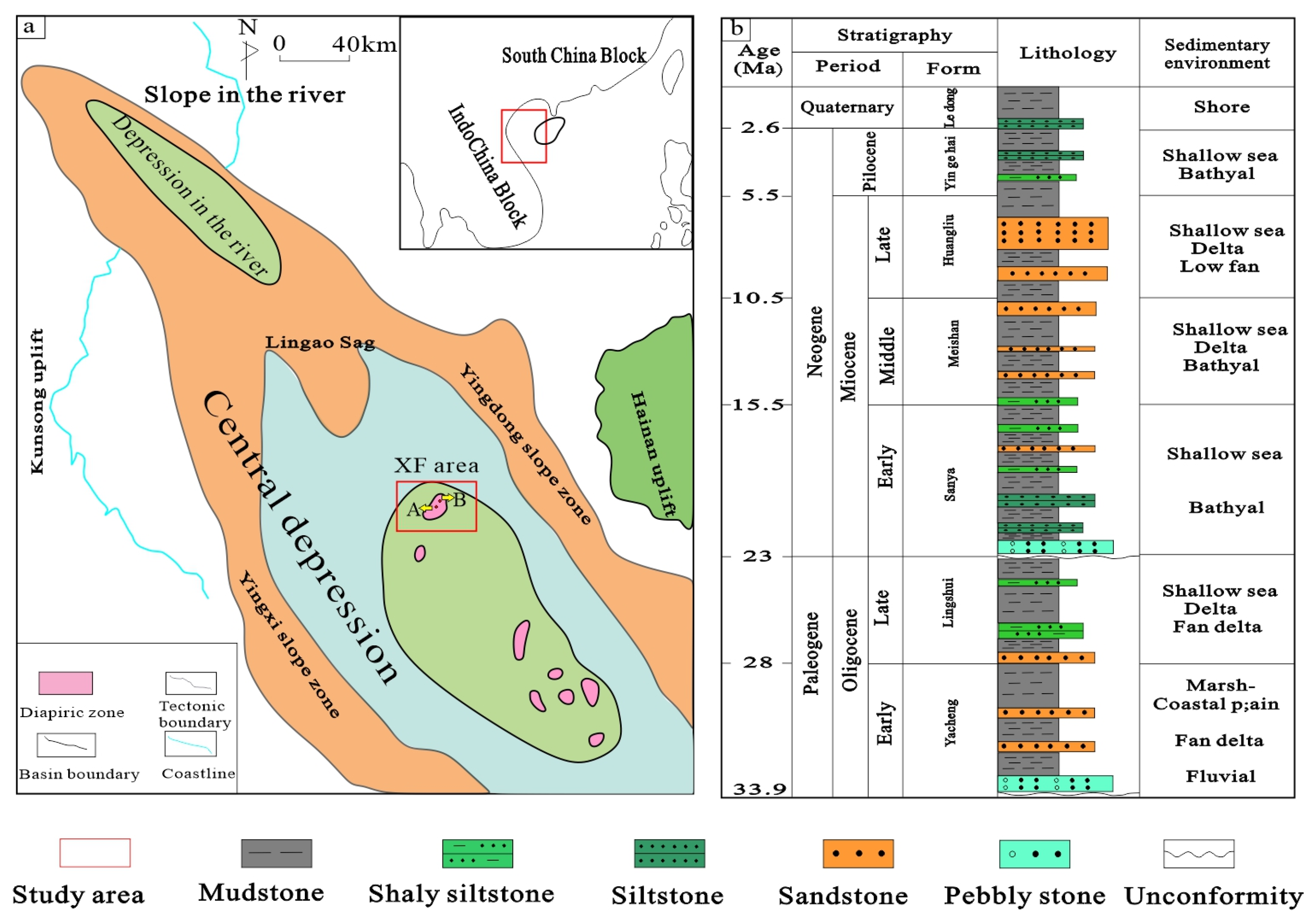

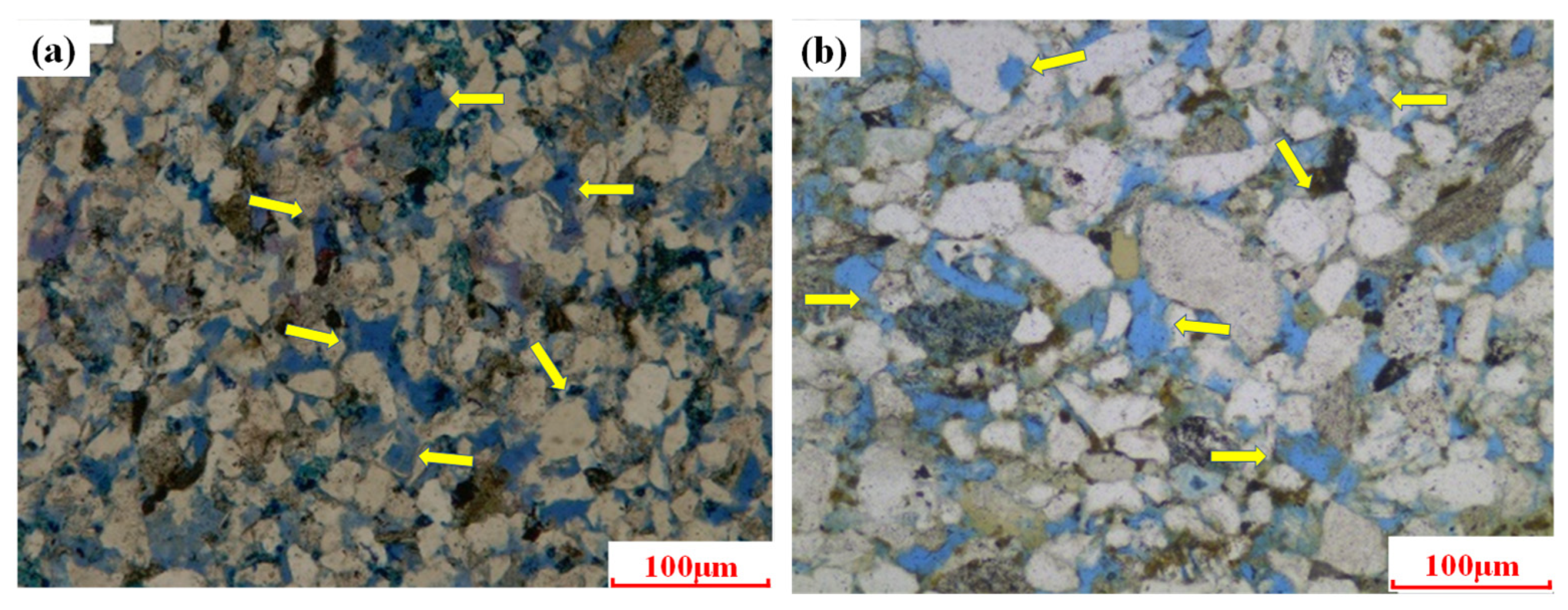

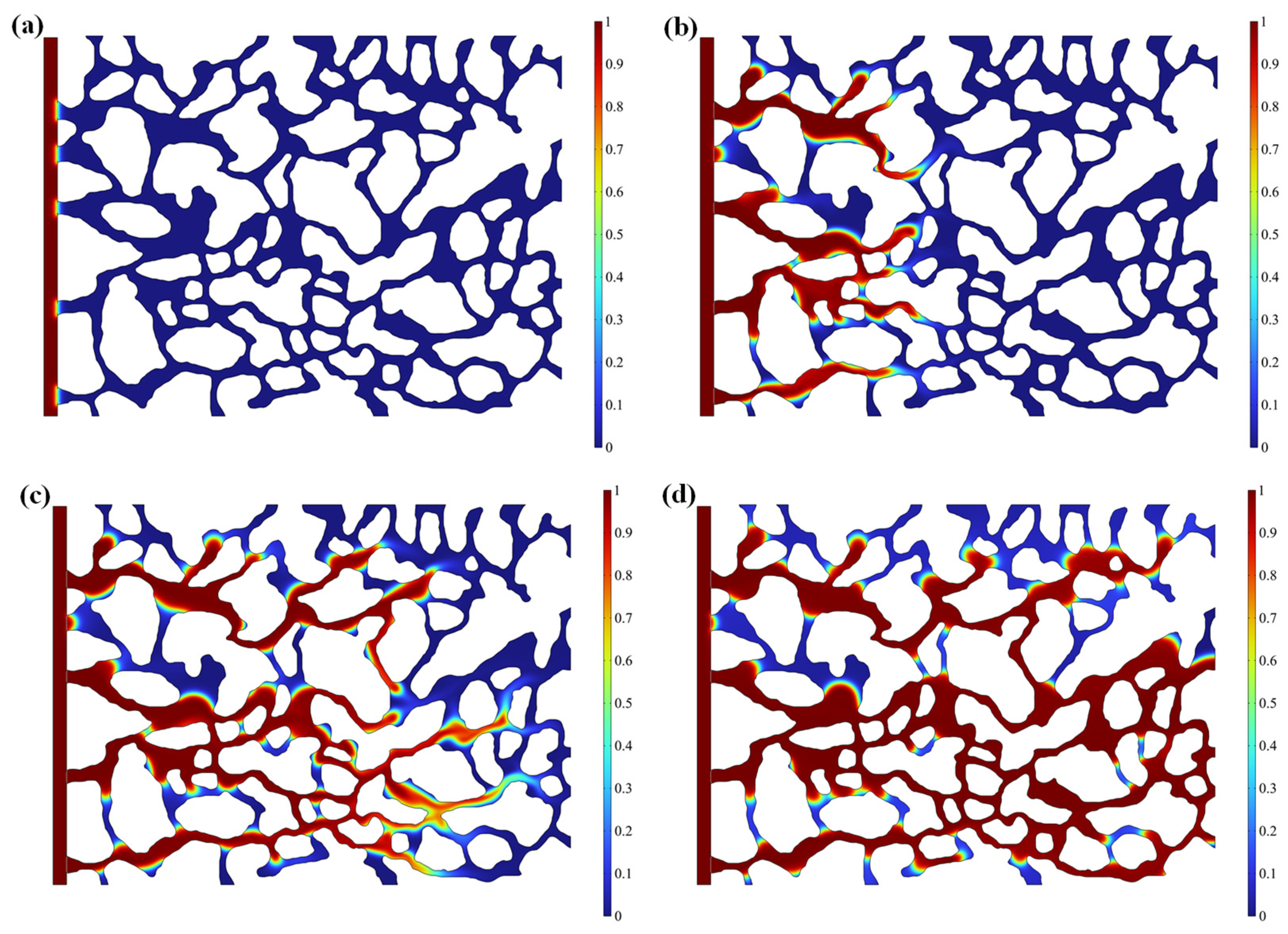

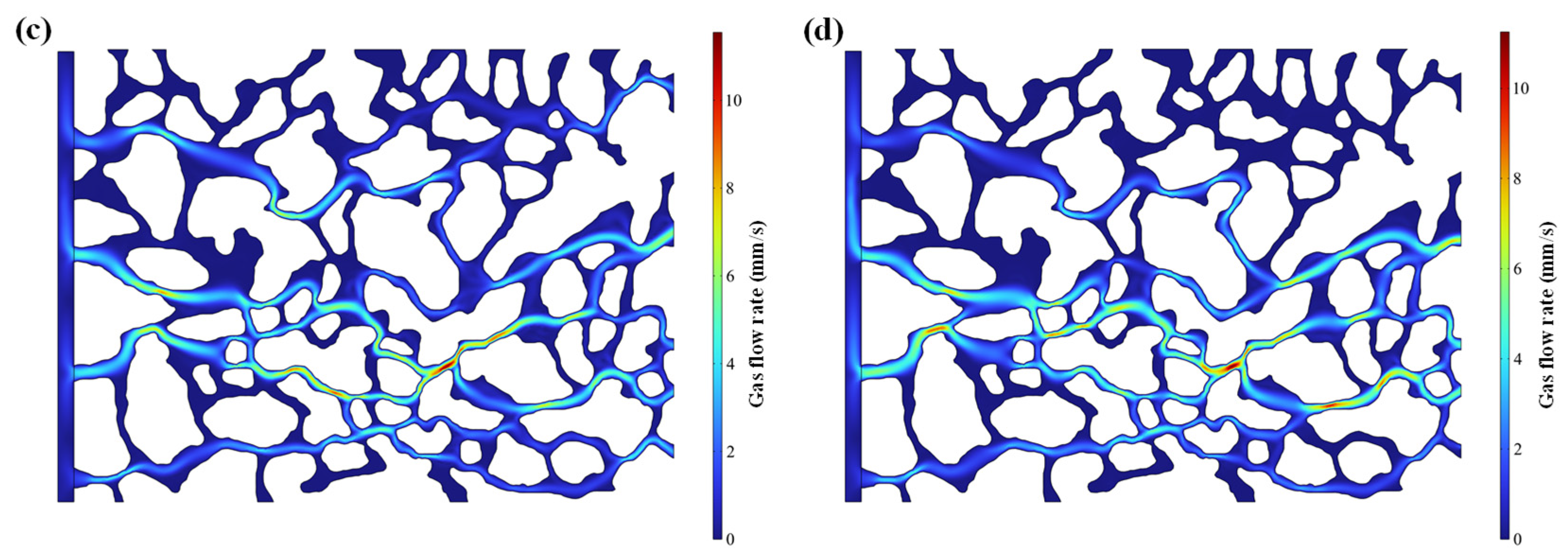
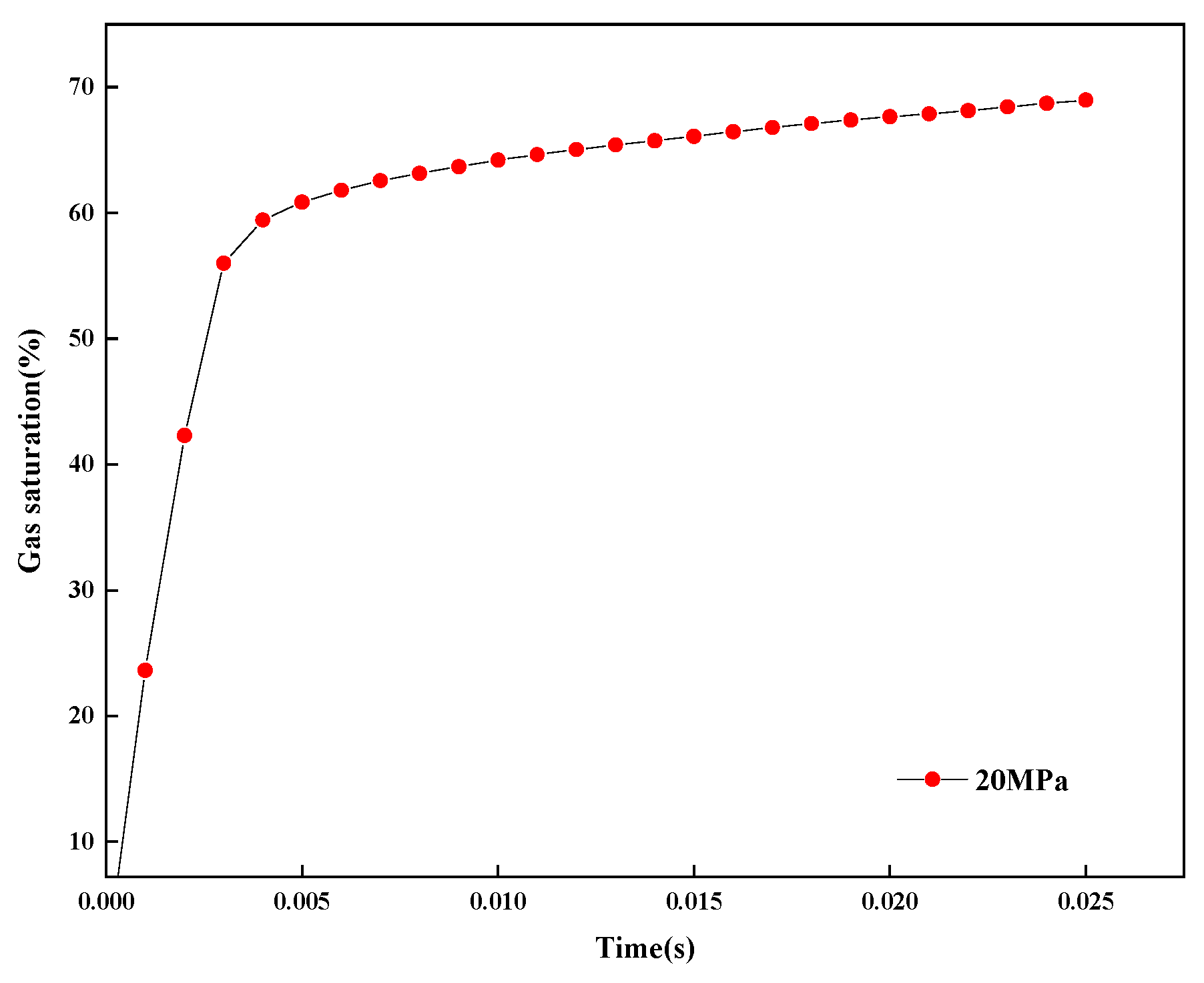
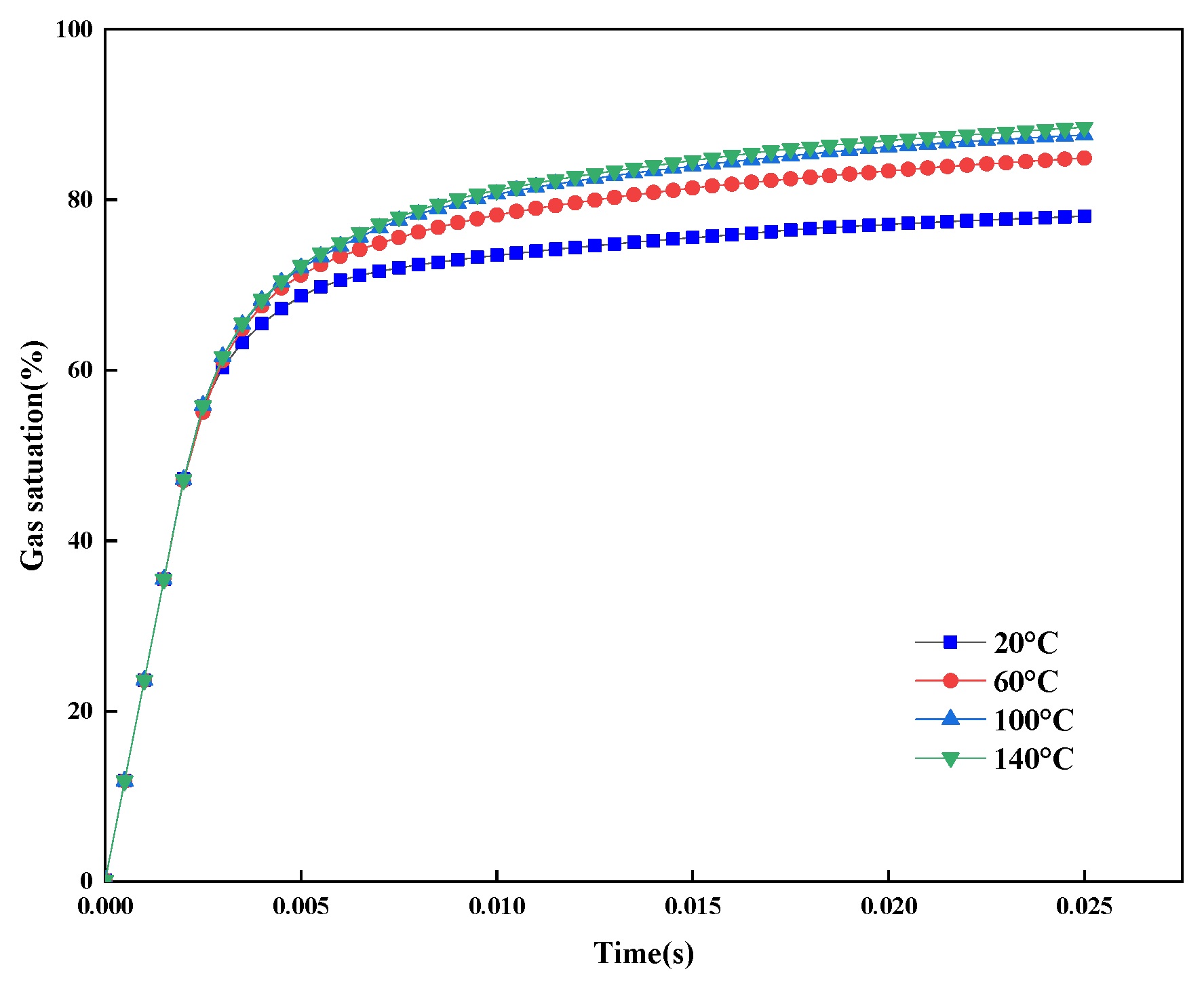

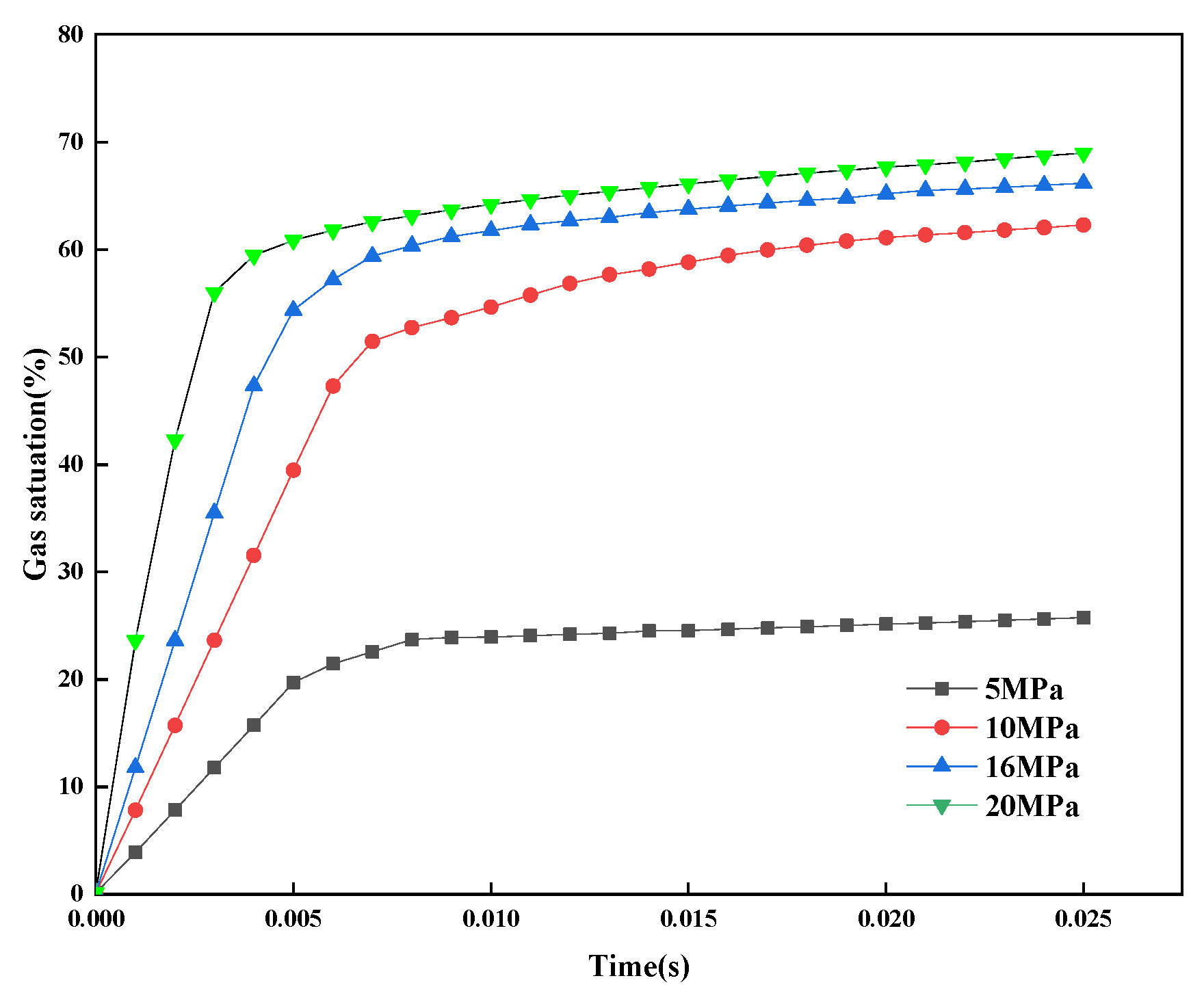
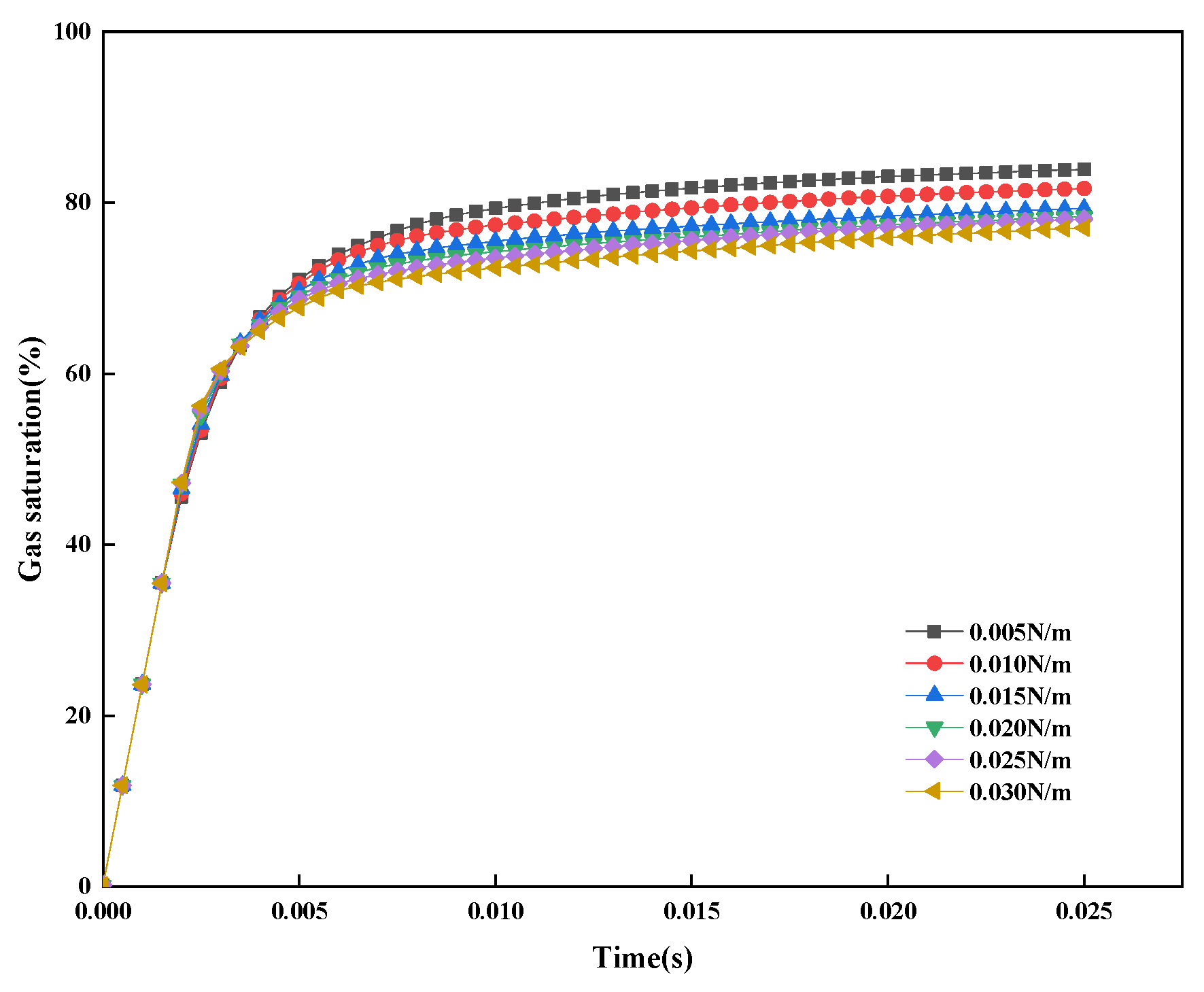

| Sample Number | Porosity (%) | Permeability (mD) | Temperature (°C) | Pressure (MPa) | Charging Pressure (MPa) |
|---|---|---|---|---|---|
| A1 | 13.20 | 0.05 | 97.68 | 34.10 | 16 |
| B1 | 11.80 | 0.45 | 137.41 | 44.0 | 20 |
| Water Density (kg·m−3) | Water Viscosity (Pa·s) | CH4 Density (kg·m−3) | CH4 Viscosity (Pa·s) | Temperature (°C) | Charging Pressure (MPa) | Wetting Angle (°) | Interfacial Tension (N·m−1) |
|---|---|---|---|---|---|---|---|
| 1.03 × 103 | 1.0 × 10−3 | 2.0 × 102 | 0.01 × 10−3 | 137.41 | 20 | 30 | 0.01 |
| Cores | Properties (%) | |||||||
|---|---|---|---|---|---|---|---|---|
| Quartz | K-Feldspar | Plagioclase | Calcite | Dolomite | Siderite | Pyrite | Clay Minerals | |
| A1 | 59 | 4 | 18 | 0 | 10 | 0 | 0 | 9 |
| B1 | 61 | 1 | 6 | 17 | 2 | 0 | 3 | 10 |
Disclaimer/Publisher’s Note: The statements, opinions and data contained in all publications are solely those of the individual author(s) and contributor(s) and not of MDPI and/or the editor(s). MDPI and/or the editor(s) disclaim responsibility for any injury to people or property resulting from any ideas, methods, instructions or products referred to in the content. |
© 2025 by the authors. Licensee MDPI, Basel, Switzerland. This article is an open access article distributed under the terms and conditions of the Creative Commons Attribution (CC BY) license (https://creativecommons.org/licenses/by/4.0/).
Share and Cite
He, T.; Li, Z.; Jiang, F.; Hu, G.; Lin, X.; Lu, Q.; Zhao, T.; Shi, J.; Yang, B.; Li, Y. Simulation Study of Natural Gas Charging and Gas–Water Occurrence Mechanisms in Ultra-High-Pressure and Low-Permeability Reservoirs. Energies 2025, 18, 1607. https://doi.org/10.3390/en18071607
He T, Li Z, Jiang F, Hu G, Lin X, Lu Q, Zhao T, Shi J, Yang B, Li Y. Simulation Study of Natural Gas Charging and Gas–Water Occurrence Mechanisms in Ultra-High-Pressure and Low-Permeability Reservoirs. Energies. 2025; 18(7):1607. https://doi.org/10.3390/en18071607
Chicago/Turabian StyleHe, Tao, Zhuo Li, Fujie Jiang, Gaowei Hu, Xuan Lin, Qianhang Lu, Tong Zhao, Jiming Shi, Bo Yang, and Yongxi Li. 2025. "Simulation Study of Natural Gas Charging and Gas–Water Occurrence Mechanisms in Ultra-High-Pressure and Low-Permeability Reservoirs" Energies 18, no. 7: 1607. https://doi.org/10.3390/en18071607
APA StyleHe, T., Li, Z., Jiang, F., Hu, G., Lin, X., Lu, Q., Zhao, T., Shi, J., Yang, B., & Li, Y. (2025). Simulation Study of Natural Gas Charging and Gas–Water Occurrence Mechanisms in Ultra-High-Pressure and Low-Permeability Reservoirs. Energies, 18(7), 1607. https://doi.org/10.3390/en18071607






